7. Semantic LTM
1/44
There's no tags or description
Looks like no tags are added yet.
Name | Mastery | Learn | Test | Matching | Spaced |
|---|
No study sessions yet.
45 Terms
Semantic memory
_______________ - Our permanent memory store of general world knowledge. All about MEANING
Loftus & Palmer
_________________- Showed people car accidents and asked:
How fast were the cars going when they ____ each other?
Follow-up question: Was there broken glass?
Smashed: 30% yes
Contacted 10% yes
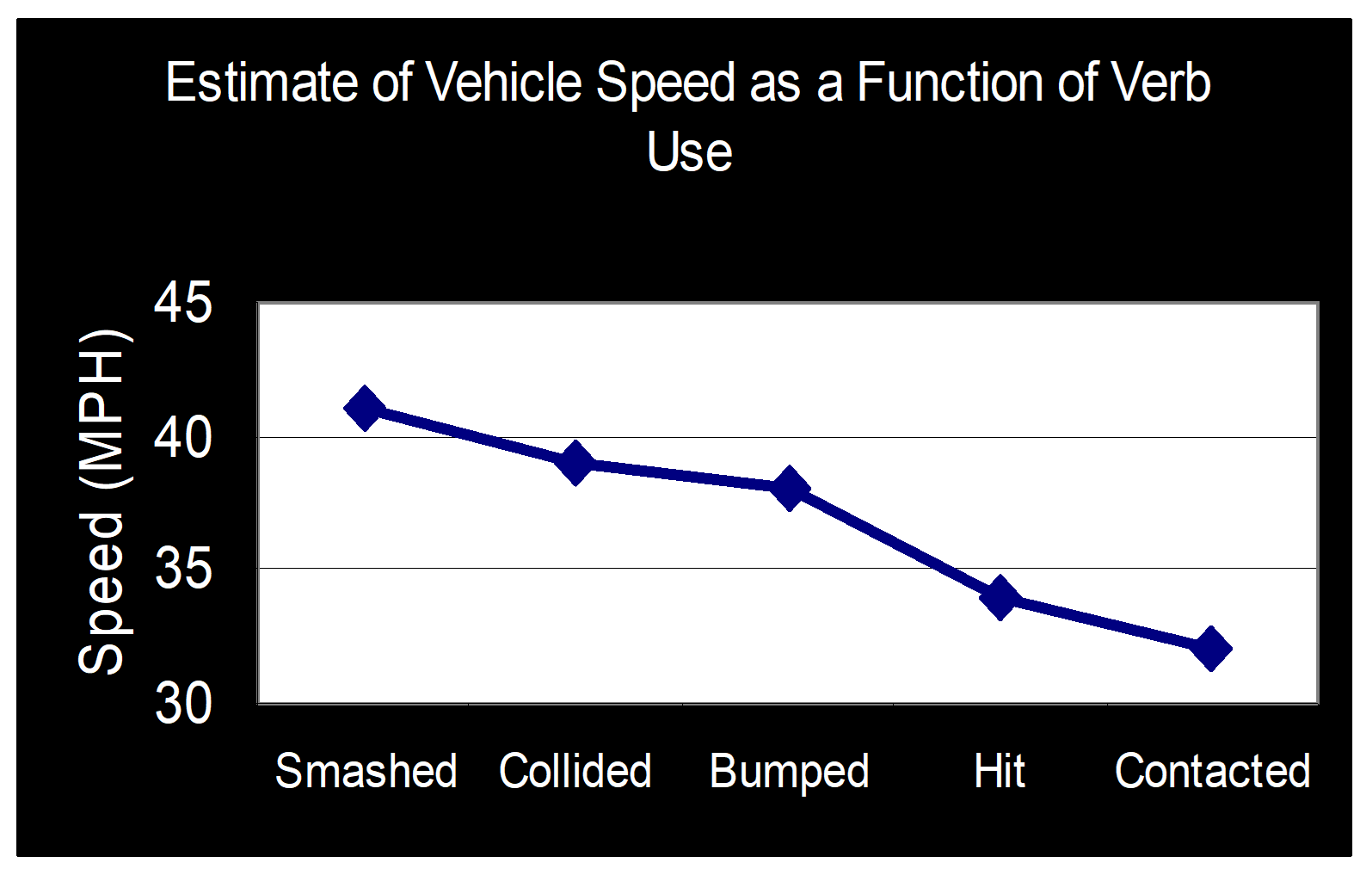
Network model of semantic memory
The Collins & Quillian Model
Network
Node
Pathways
Network
The Collins & Quillian Model/Network model of semantic memory
_________________ - An interrelated set of concepts/ body of knowledge
Node
The Collins & Quillian Model/Network model of semantic memory
_______________ - A point of location in the network representing a single concept
Pathways
The Collins & Quillian Model/Network model of semantic memory
________________ - Labeled directional associations between concepts
Spreading activation
_________________ - The mental activity of accessing and retrieving information from the network
Takes passive concepts and activates them
Activation then spreads to related nodes
e.g., activation of the “planet” node would also spread to the “earth” node or the “moon” node
Sample of the Semantic Network
A) The word “robin” is activated
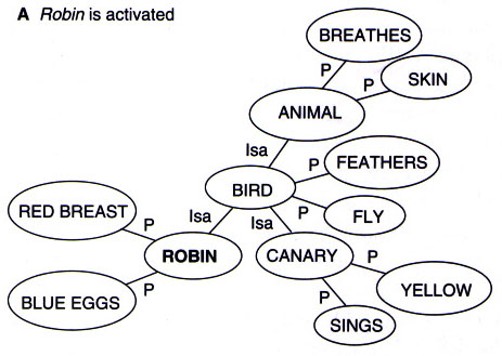
Propositions
________________ - Express a relationship between two concepts
Examples:
A robin has wings
An apple is a fruit
Pathways + propositions
__________ + _________ - Pathways connect two nodes together to form propositions
“ISA” pathways express category membership
E.g., a robin is a bird
Property pathways express properties that concepts possess
E.g., A robin has the property of wings
Intersection search
_____________ - Two concepts can be activated, each with spreading activation to related nodes(spreading activation) — the two spreads of activation eventually collide—and intersection—which lets you answer: True, a robin is an animal.
True of False: A robin is an animal?
Activation lights the robin node, and then spreads to its neighbors
`E.g., bird, blue eggs, red breast
Semantic relatedness
________________ - The distance between two nodes in a network is determined by ______
Concepts close in meaning/highly related (e.g., doctor and nurse) are stored close together in memory
Unrelated concepts (e.g., doctor and truck) are stored far away

Smith’s Feature Comparison Model
______________ - Semantic memory is a collection of lists
Feature Lists
Feature lists
Smith’s Feature Comparison Model
_______________ - Contain semantic features (simple, one element characteristics) of each concept stored in memory
…have a much simpler structure than network models
They are more parsimonious (Occam's razor) — easiest explanation is prolly the right one
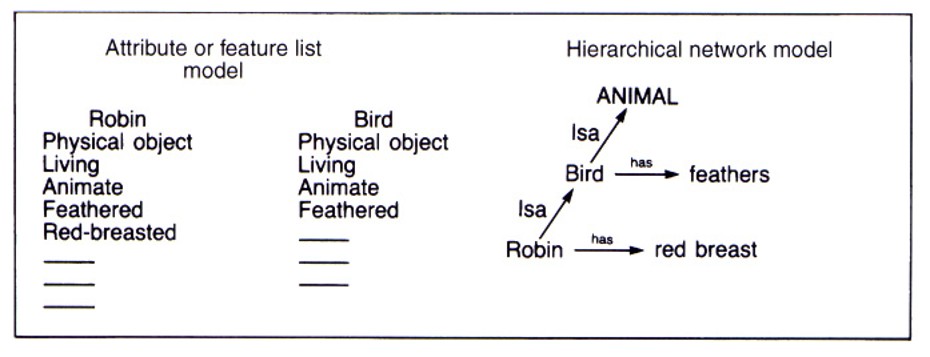
Defining features
Feature lists
_______________ - Features absolutely essential to the concept
Robins must be physical objects, have red breasts and feathers
Defining features appear at the top of each feature list
Characteristic features
Feature lists
_____________ - Features that are common but not essential to the meaning of a concept
E.g., A robin perches in trees
Characteristic features appear at the bottom of each feature list
Feature comparison
________________ - The major process of information retrieval in the feature list model is this
Mind makes heuristic comparisons
True or false: A robin is a bird?
To answer, first access each feature list from memory
Stage 1: Comparison is fast and involves a global comparison of how much the features in each list overlap
Second, compare each list for common features (feature overlap
Stage 2: Comparison is slow, occurring only when the lists have an intermediate amount of overlap
Stage 2 involves only the defining features of each list
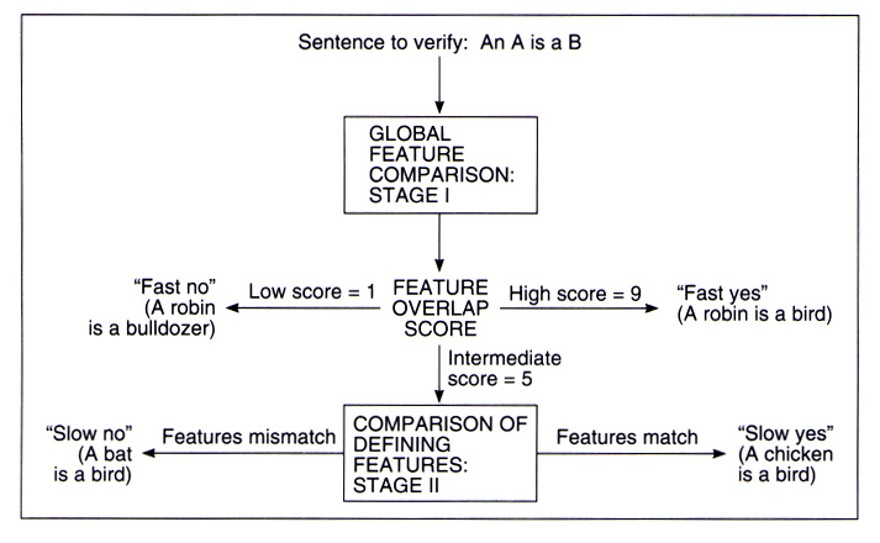
Problems w/ feature comparison
Feature lists → Feature comparisons
_______________- No objective way to define a feature as a defining or characteristic feature
Does not account for fuzzy boundaries
Many items in a category do not share a defining feature
E.g., are bookends pieces of furniture?
How many features of a bird can you lose and still have a bird?
Limited feature lists
Why would the robin list contain every important concept about robins except that a robin is a bird?
Empirical tests of the network model
_______________ - Used the Sentence Verification Task
True or False, an x is a y?
E.g., True or false, a robin is a bird?
Response Time is measured
Collins & Quillian (1969) Key Prediction:
Two concepts that are closer in the network should take less time to verify than two that are farther apart.
Collins & Quillian
Empirical tests of the network model
_________________ (1969) - proposed semantic memory formed hierarchical associations between different categories of knowledge.
Good initial results, but the results of other research indicated problems with the idea
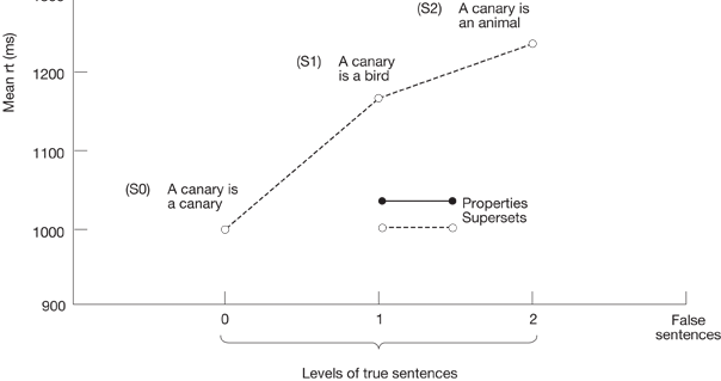
Semantic relatedness and concepts
Semanticity
________________ - Concepts that are more highly interrelated are retrieved faster— organized around meaning
Ex: Name the 12 months of the year
Now, name them in alphabetical order
Typicality effects
Typicality
_______________ - Some members of a category are more typical – more representative – than others.
More typical members of a category are judged faster than are less typical ones.
“A robin is a bird” is verified faster than is “a chicken is a bird”
Models:
The Feature Comparison Model was built to explain typicality effects
Adding semantic relatedness to the network model allows it to explain typicality effects
Cognitive economy
_______________ - The incorrect notion from the original network model that redundant information is NOT stored in semantic memory
Redundant Information is stored in memory
E.g., Breathes appears under the animal node and under the robin node, under the human node, etc.
The Revised Network Model
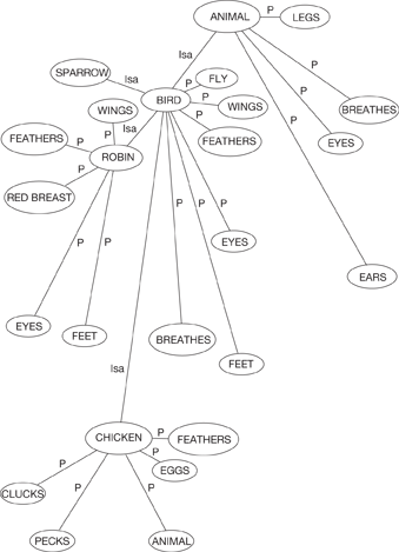
Schema
______________ - mental framework or body of knowledge about some topic
Example: Bartlett’s “War of the Ghosts” study
When a child is young, they may develop a schema for a dog. They know a dog walks on four legs, is hairy, and has a tail.
Categorization
________________ - Combining entities (information, objects, people, events, etc.) into meaningful units, or categories, is critical for semantic memory
Organization
This help us quickly make sense of the world
Categorization can have drawbacks
E.g., Stereotypes
Classic view of categorization
Categorization
_________________ - People create and use categories based on a system of rules
If something satisfies a set of rules, then it is a member of the category
Necessary features: if not present, not a member of category
Sufficient features: Nothing more is needed to satisfy category membership
Arranged according to scientific taxonomies
Graded membership
Characteristics of human categories
_______________ - Categories are loose and fuzzy
Some members of categories are “better” members than others
•E.g., eagle is a “better” bird than ostrich

Central tendency
Characteristics of human categories
______________ - there is some mental core or center to the the category where the best members are found
Typicality
Typicality
Characteristics of human categories → central tendency
_____________ - the degree to which items are viewed as typical, central members of a category
Prototype theory
Prototypes and exemplars
_______________- the central or core instance of a category
The prototypical bird may not even exist in the real world
Compare new entities to established prototypes —Allows for graded membership
Limitations:
No information about variability of members
No information about category size
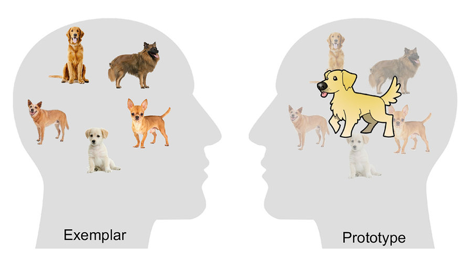
Exemplar theory
Prototypes + exemplars
_______________ - People mentally take into account each experience, instance or example, of the encounters they have had with members of that category
We store exemplars in our memory
Judge new information by its resemblance to the stored exemplars
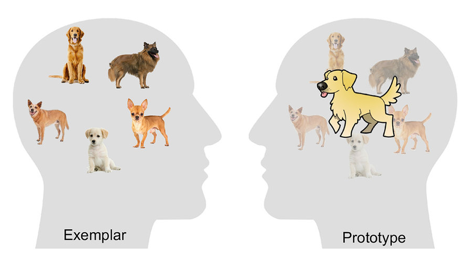
Explanation-based categorization
Categotization
_______________ - Semantic categories are theories of the world we create to explain why things are the way they are.
Ad hoc categories
Psychological essentialism
Ad Hoc categories
Explanation-based categorization
____________ - Categories created as needed, often spontaneously

Psychological essentialism
Explanation-based categorization
_______________ - Members of a category are treated as if they have the same underlying property or essence

Basic Principles of Semantic Priming
Priming in semantic memory
______________
The priming process takes time
The activation of primed concepts is smaller the more removed concepts are from the origin
Nodes are activated for a short amount of time
The priming effect is reduced across time
After activation, they return to baseline
Priming
____________ - an exposure of info which can influence the processing of info
Stimulus presented first in the hopes of influencing some later process
Target
Priming in semantic memory
_____________ - the stimulus that follows the prime
Facilitation
Priming in semantic memory
_____________ - Prime decreases processing time needed for the target
Inhibition
Priming in semantic memory
_____________ - Prime increases processing time needed for the target.
Implicit priming
_______________ from Marcel (1980) - trying to see how info we aren’t consciously aware of can influence our processing of info
Lexical Decision Task: “yes/no” this is/isn’t a word
Presented primes followed by a “mask” (scrambled visual patterns)
Participants were unaware of the prime
Primes facilitated lexical decisions even though Ps were unaware of the prime
Conclusion: Priming is an implicit process (partly
Say: “child” -> then toddler -> the toddler shows up easier in your mind because it was primed
Context effects
______________ - Simpson (1981): Ambiguity and priming
Target word: Duke
“The vampire was disguised as a handsome count.”
Context effects are semantic priming effects (based on meaning)
Facilitated priming, similar to the Marcel study. Marcel study just accounts for visual stiff because of scrambled visual patterns
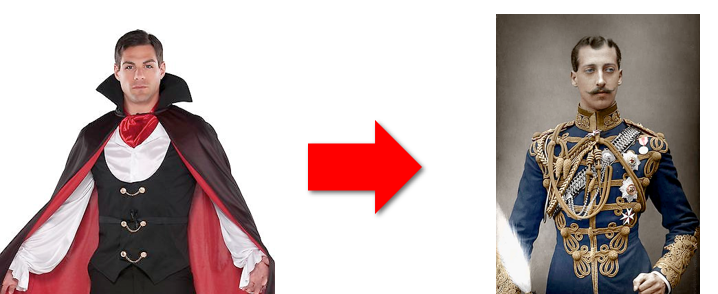
Lexical memory
______________ - The mental lexicon or dictionary where word knowledge is stored
Distinct from conceptual knowledge
Anomia
______________ - deficit in word finding
Kay & Ellis (1987)
PDP models can be “lesioned” to mimic the effects of anomia
Can have an idea in mind but not be able to find it
Category specific deficit
_______________ - A disruption where a person loses access to one semantic category of words but not others
E.g., Patient J.B.R.
Had problems naming living things, but no problems naming non-living things
What caused this dissociation?
Warrington & Shallice (1984): Disruption in sensory versus functional knowledge